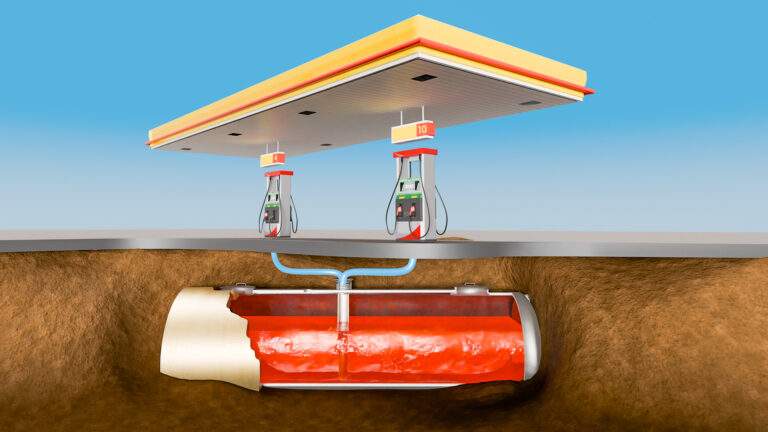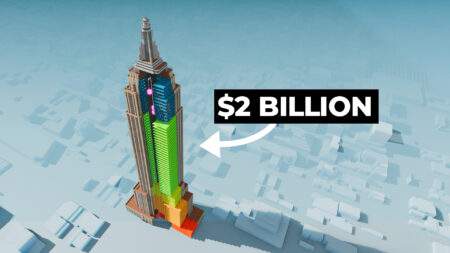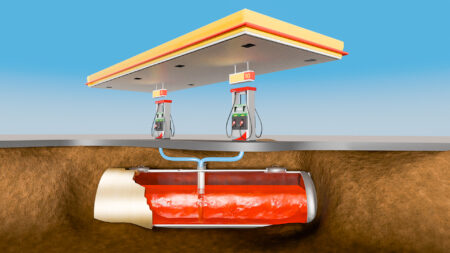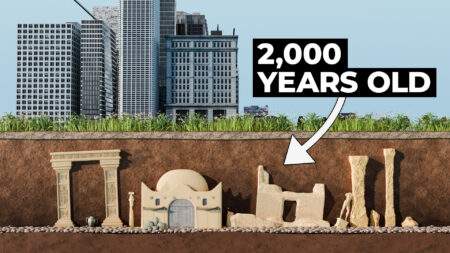This is the Empire State Building. When it was built almost 100 years ago, it became the tallest building in the world by far. It was its own vertical city, housing thousands of workers, a cafe, its own postal system – and thanks to its counterintuitive design, it became a money-making machine. Today, almost 100 years later, this single building still pulls in more than $500 million every year, beating every modern skyscraper around today.
This is all thanks to the incredible long-term thinking by its designers, who figured out how to overcome strict building rules and assemble this engineering giant in record breaking time.
But how did they pull it off and why is it still so profitable?
The skyscraper boom
In the 1920s, cities around the world were changing. The economy was booming, and with new steel-frame construction methods, it became easier to build taller and stronger buildings. Nowhere was this more important than in New York City. With limited space and an ever-growing population, the only way to build was up.
This started what became known as the race into the sky – and by the end of the ‘20s, developers began constructing several skyscrapers around Manhattan, all aiming to be the tallest in the world. Most of this was driven by ego, but building upwards also presented an enormous financial opportunity.
By purchasing some land and filling it with floor after floor rentable office space, a huge amount of money could be made – the building itself could become a business.
No one understood this more than New York businessmen John Raskob and Al Smith – and in 1929, they announced that a new building would be joining the New York skyline, the Empire State Building.
Announcing the Empire State Building
Not only was it to be the tallest building in the world, but its clever design and ultra efficient engineering was meant to make it the most economically successful building ever made.
The designers had big ideas: exclusive viewing platforms, giant radio antennas, docking stations for airships and floor after floor of premium office space.
In order for the Empire State Building to become a money-making machine, it wasn’t as simple as building tall and maximizing rental space.
Skyscraper economics
Each level that gets added onto a building gets more and more expensive – the building itself needs to be made stronger, using more material and leaving each floor with less usable space. Less space means less income – and so, after a certain height, a building stops making financial sense.
New York’s strict zoning laws
On top of that, New York had strict building rules that stopped large skyscrapers from blocking out too much light. These rules drew a sloped line up from the center of the street at around 25 degrees. Buildings weren’t allowed to occupy the area outside of the line, and so the designers had to add in setbacks, to reduce the building’s width and keep it within the line.
With these rules, it may seem like the best way to maximize floor space and therefore income would be to build right up to the line, creating a chunky pyramid-shaped building. While many buildings followed this design, it really wasn’t a practical shape for a skyscraper.
With more people at the bottom of the building and very few at the top, the demand on the elevator would be uneven. At the bottom, there would be severe delays, and at the top it would be completely underused. More elevators could be added to even out the demand – but this would simply take up too much space, reducing the profitability of each floor, particularly at the top where the most expensive offices were located.
The ideal office space was bright and quiet – so areas close to the window and high above the noisy street were the most desirable. These premium areas, fit for executives and CEOs could fetch up to $3 per square foot in yearly rent.
But as you got further from the window and closer to the ground, this would drop to just over $1 per square foot. The pyramid design simply maximized the cheaper offices at the bottom, while sacrificing the premium offices at the top.
What the designers really wanted was to keep the building as tall and as straight as possible, but this didn’t fit into New York’s strict building rules.
However, the rules had one specific term that the designers of the Empire State Building really understood.
Although a building couldn’t cross the sloped line, if part of the building was reduced to just 25% of the total plot area, it could cross the line – and it could keep going. This was a very important detail.
The Empire State Building’s design
And so, the designers of the Empire State Building decided to set back their building much earlier, well within the sloped line at around the 5th, 20th and 30th floor. From here, the building would rise up, completely uninterrupted for more than 40 floors until a few minor setbacks carried it to the 86th floor. The result was an enormously tall and straight building that had almost 3 million square feet of office space.
Although it didn’t maximize all of the space under the slope, it sacrificed the cheaper office space at the bottom to have much more premium office space at the top. With the population spread out more evenly, they were able to place fewer elevators into a central core of the building, leaving a 28 ft ring of premium office space around the whole building. But building a skyscraper this big would only be possible on a huge plot of land.
Location, location, location
At the time, most skyscrapers were being built in Lower Manhattan, which had become the financial center of the world. This made sense, because it had the demand and money to fill 80 floors of a building. But the developers of the Empire State Building thought differently.
They saw that the business center of New York was slowly creeping northwards, and so they took a gamble and bought a plot of land in Midtown for $16 million, hoping that one day it would be the new thriving business center of New York.
The plot still contained the old Waldorf-Astoria hotel, but after demolishing it, the developers ended up with a plot more than 400 ft long and 200 ft wide. A plot this wide was extremely rare in New York, and it provided the perfect base for the world’s tallest building. The next step was to actually build the thing – and it had to be done in record time and on a tight budget of just $35 million.
Tight budget and scheduele
In New York, there were two lease dates throughout the year; May 1st and October 1st. If a building wasn’t finished in time for either of those dates, it would have to sit empty until the next lease day, losing an incredible amount of money.
And so the target was set, the Empire State Building had to be finished by May 1st, 1931, just a little over a year away. What followed was one of the most incredible displays of efficiency and planning any engineering project has ever seen.
Every hour of the day was meticulously scheduled, with multiple phases of the build happening simultaneously.
Building the Empire State Building
The main structure of the building was made from prefabricated steel columns and beams. Almost all of them were identical – and so they could be manufactured, shipped out to the worksite and put together in record time.
With hundreds of deliveries each day and over 3,000 workers on the site, the building rose by more than 4 floors each week. Railway carts on each floor were built to move material around quickly, and small cranes placed throughout the building would lift the steel beams up to the highest floors. There were even multiple restaurants placed throughout the building, saving the workers time by not having to leave the work site.
In just 6 months, the entire steel structure had been put together – and another 6 months later, the entire building was complete, coming in under budget at just $25 million. It was now ready to be rented out.
But just as it opened for business, the worst financial crash in history hit America. 12 million people lost their jobs and wages across the country fell by 45%. It was a complete disaster for the Empire State Building, which struggled to fill even a quarter of its office space, earning it a rather unfortunate nickname. Thankfully, the building was much more than just a giant office.
Viewing platforms
On the 86th and 102nd floor were two observatories, giving tourists a view of New York that towered above every other building. Tickets cost $1, or $20 in today’s money, and it became a hit right away. In its first year, it sold over 1 million tickets, and throughout the ‘30s, it became the main revenue stream for the building, until its offices finally recovered from the crash. But the Empire State’s money-making ability didn’t end there.
Radio and TV Antenna
Above all of this was a giant mast – originally designed as a docking station for airships, where passengers could disembark and make their way down to the ground in just a few minutes. This idea ultimately never took off, but the mast ended up serving a much more lucrative purpose.
The designers always knew that such a tall building would be a great place for a radio transmitter, since its unobstructed height would allow it to reach far and wide.
And so, in 1931, they converted the mast into a giant antenna and rented it out to NBC. This earned them a steady income, but the real money-maker was just around the corner.
Television was coming along and the Empire State Building became the perfect place to develop the technology. NBC took over the 85th floor, installed a 50,000 watt transmitter and performed the world’s first high-powered transmission. This provided signal to the whole city and formed the basis of how TV ended up working across America. It was so tall that its signal could reach as far as Rhode Island or Massachusetts, well over 100 miles away.
Television exploded, and the Empire State Building’s antenna started broadcasting 9 different TV stations across 4 different states, earning it more than $600,000 a year, or around $7 million in today’s money.
Empire State Building annual income
The Empire State Building remained the tallest building in the world for 40 years, until the World Trade Center finally took over. Although there are many larger skyscrapers around today – thanks to its design, the Empire State Building still blows them all away.
From office rentals alone, it pulls in $350 million dollars each year and houses some of the world’s biggest brands. Its TV and radio antennas generate around $30 million annually and the viewing platforms generate an incredible $130 million every year.
The gamble on its location paid off, and the building now sits right at the heart of New York’s busiest area, giving the building an overall value of over $2 billion. No matter how you look at it, the Empire State Building was an engineering masterpiece.












